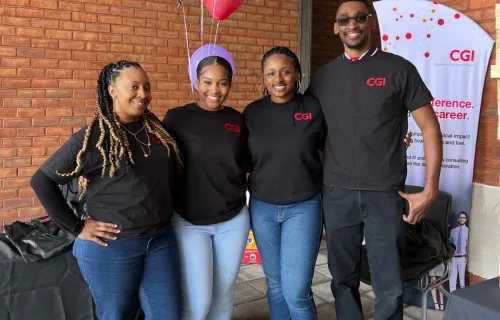As I reflect on International Women’s Day and the focus on embracing equity in the workplace, it brings to mind my own personal experience and the support I received from my employer. When my oldest son arrived eight weeks early, my boss asked a colleague in a similar business role to help me. She would call and work through critical tasks as I found time while watching over my son at the hospital’s neonatal intensive care unit. It was true teamwork, allowing me to be where I needed to be and ensuring that work didn’t get dropped, given his unexpected early arrival. Not only did this support help me reengage with work when I returned from maternity leave, but it also made me feel appreciated, and valued and increased my loyalty to my employer for years to come.
According to the International Women’s Day website, “equity is defined as giving everyone what they need to be successful” 1. It’s important to note that the tools for success are not one-size-fits-all - people need varying resources and support to ensure success depending on their stage of career, industry, geography, demographic, etc. Taking a cookie-cutter approach to providing the necessary support would be insufficient and doomed to fail.
Women hold many roles – parent, spouse, partner, daughter, caregiver, learner, teacher, manager, expert, employee, colleague, community contributor, friend and more. As we celebrate International Women’s Day and this year’s campaign theme of Embrace Equity, we must remember to respect and support women fulfilling these roles while balancing multiple responsibilities. Challenges are often compounded for women of color, women with disabilities, and queer or transgender women, making it especially important to address equity, including creating pathways to enable business success and achieving personal career ambitions for all women.
As I think about these roles and life circumstances, it occurs to me that the working world needs to continue to look for opportunities for equity in supporting women to succeed in their careers while balancing their non-work related responsibilities. Not only is it good for women but multiple studies show that having women in leadership doesn’t “just improve financial performance metrics, they also de-risk firm performance.”2 In other words, retaining and advancing women is good for business. In addition:
- Studies3 show that women without children are often given additional work to support those trying to balance parenthood
- Men are typically praised when participating in child-raising responsibilities and are less likely to be limited in their career choices because they are a parent
Up to 81% of all caregivers are female, and they may spend as much as 50% more time giving care than males.4 Elder caregiving is rapidly increasing as the population ages, with more than 61% of elder caregivers being women5. When CGI started the Working Caregivers Member Resource Group (MRG) several years ago, we surveyed the MRG members (CGI calls our employees members as we all share in the business outcomes and as shareholders) and were surprised that the majority of members were elder caregivers. Many members provided both child and elder care, and this adult caregiving was a largely unsupported community. CGI stepped in to help fill the void through the MRG.
Finding equity in the workplace
So how do we find equity and balance in the workplace? It comes down to meeting people where they are in their careers and supporting them with programs that promote equity:
- Leaders have regular discussions with employees (women and men) to ask what they want and need to have a meaningful, balanced career and home life. Managers should not assume that women, especially working mothers or caregivers, are limited in their work abilities or aspirations because of other obligations, but rather offer them opportunities that align with their goals and capabilities. According to a SurePayroll survey, “64% of moms said their drive to climb the corporate ladder was already high before their child’s birth, and 54% of working moms are more motivated than ever to continue their career ascension.” 6
- Leaders recognize the value of flexibility7 and the opportunity to allow partial or full remote work and job sharing to support career contributions for caregivers and non-caregivers. The need for this flexibility was only heightened by the pandemic. 8
- Women recognize that careers are not linear, and there may be periods when deciding to dial back career aspirations to focus on family may be necessary. Women also recognize the importance of clearly communicating aspirations and proactively advocating for advancement opportunities when the time is right. 9
- Men embrace their abilities to be caregivers and share more responsibilities.
- Organizations develop mechanisms and opportunities for women to re-enter the workforce through avenues like the CGI IT Academy, which trains individuals looking to enter/re-enter the IT industry with critical skills such as data engineering.
- Companies recognize the need for more modern benefit packages that include caregiver benefits, especially as the population ages and elder care needs increase. 10
There will always be challenges to balancing work and non-work responsibilities. To retain and advance women in the workforce, it is essential to proactively support flexibility, encourage communication, and provide opportunities to support caregivers where they are. As a society, we will be enriched by these actions. However, they should not rely on a single manager’s discretion (as I positively and thankfully experienced) but must be embedded into an inclusive and equitable work culture for all.
Learn more about CGI’s commitment to increasing diversity, equity and inclusion across our workforce, suppliers and more.
Read more CGI member stories in the Life at CGI blog series.
Want to join us? Find your next opportunity at CGI Careers or join our talent network.
1 www.internationalwomensday.com
2 The Business Case For Women In Leadership (forbes.com)
3 How to say no at work when you don't have kids - BBC Worklife and The Brutal Truth About Being Childless at Work | Fortune
4 The Gender Gap in Caregiving and Why Women Carry It | UMKC Women's Center
5 2023 Caregiver Burnout and Stress Statistics (aplaceformom.com)
6 www.surepayroll.com/resources/blog/moms-returning-to-work
7 How Managers Can Be Fair About Flexibility for Parents and Non-Parents Alike (hbr.org)
8 Workplace Flexibility: What It Is & Why It Matters (topworkplaces.com)
9 What’s Really Holding Women Back? (hbr.org)
Supporting Employees with Caregiving Responsibilities (shrm.org)






